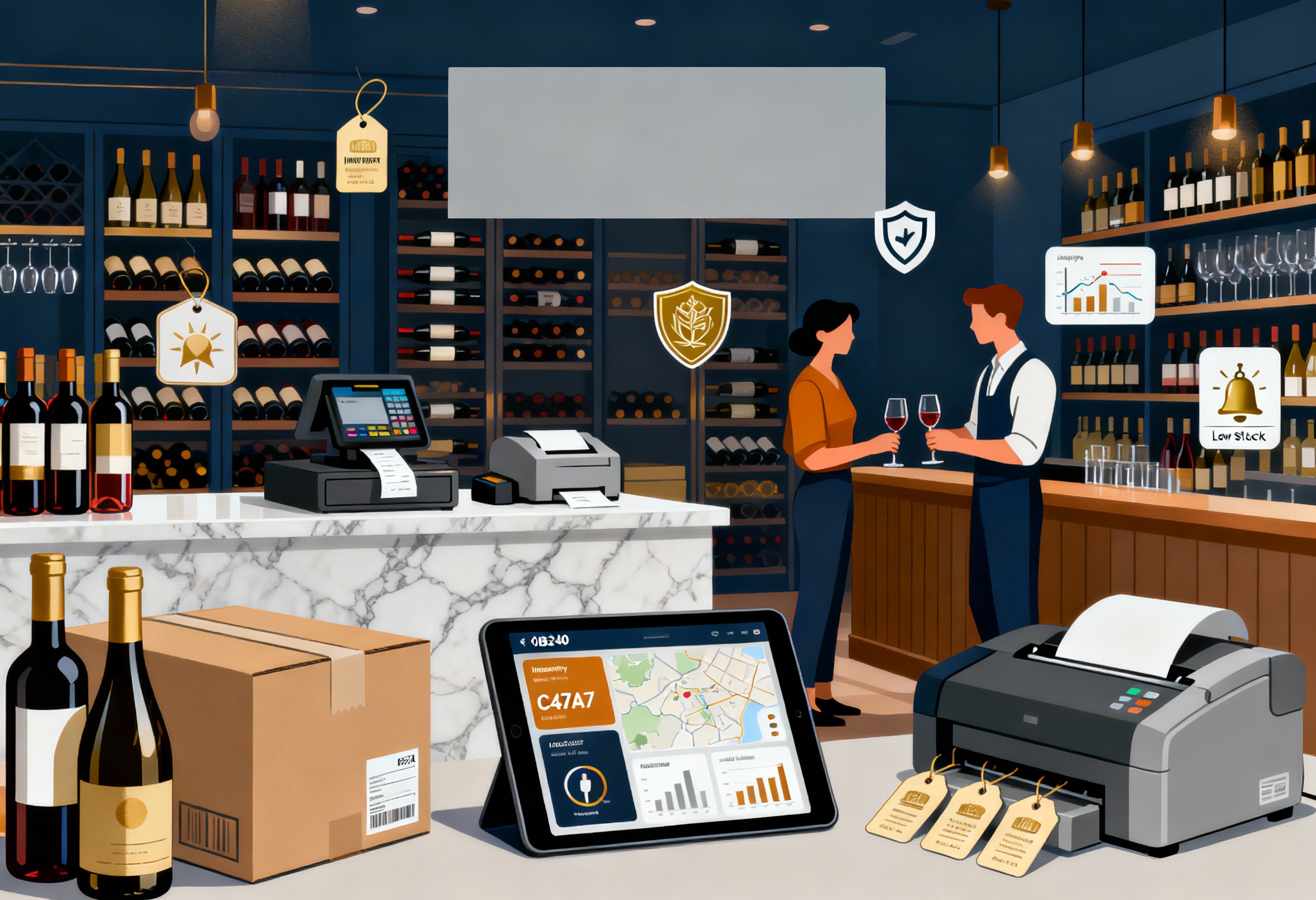Finding the best optical POS software today isn’t just about keeping the checkout line moving. It’s about making sure patients stay loyal, staff stay sane, and stores stay ahead. The right system doesn’t just track sales; it becomes the heart of a smarter, faster business.
We’ll take a closer look at where the industry is heading before picking the top solutions for 2025.
Highlights:
- Optical POS systems in the US are shifting toward cloud-based platforms, AI-driven tools, and seamless omnichannel experiences.
- The right optical POS should handle inventory smartly, support patient care, simplify billing, connect with EHRs, and deliver meaningful insights.
What’s Trending in Optical POS Across the US?
Cloud-based setups are now the new normal for optical retailers. According to Technavio, cloud-based optometry software in North America is set to grow by over 9.8% CAGR through 2028, with clinics demanding anytime, anywhere access to patient records, inventory, and sales tools. Clinics no longer want to be chained to a desk. They want mobility, faster updates, and real-time visibility across locations.
Artificial intelligence is also reshaping the way optical stores operate. According to a 2025 report by Exploding Topics, 48% of businesses are using AI to analyze big data effectively. Optical clinics are joining that shift, using AI to recommend lens upgrades, flag expiring prescriptions, and predict next purchases. It’s no longer just about selling glasses; it’s about knowing what the patient needs before they even ask.
Meanwhile, the push for omnichannel shopping is heating up fast. IHL Group reports that inventory distortion, including out-of-stock or overstock issues, costs U.S. retailers over $27 billion a year. Optical stores are syncing online checkouts, appointment booking, and in-store inventory to keep patients from bouncing to a competitor. Patients expect a seamless experience whether they click or walk through the door, and smart optical POS systems are making that happen.
Why Are US Optical Stores Moving to Modern POS?
Old-school cash registers and paper schedules can’t keep up with today’s optical demands. Automated POS systems are saving hours every week by cutting down on manual entry, order duplication, and billing errors. Shopify shows that retail businesses with real-time POS systems report 56% faster checkouts compared to those using traditional setups, giving staff more time to focus on patient care instead of paperwork.
Fast checkouts aren’t just about saving time. They’re about keeping patients happy. Optical stores using mobile POS or self-service checkouts are dramatically shrinking wait times, creating smoother experiences that boost loyalty and increase repeat visits.
Real-time stock information is another big win. According to a 2025 study published in the Journal of Recent Trends in Computer Science and Engineering, implementing real-time inventory management systems led to a 30% reduction in stockouts within the grocery sector. This helps optical retailers avoid disappointing customers. Knowing exactly what’s in stock and where it’s located means fewer lost sales and tighter inventory control across every shelf and storeroom.
Better yet, a next-gen POS software turns daily sales into smart planning. Salesforce indicates that 86% of small and medium businesses adopting AI have observed improved profit margins. This highlights the significant impact of AI integration on business performance. Instead of guessing what to order, optical retailers can see trends, predict demand, and keep the right frames and lenses ready before the patient even walks in.
What should you look for in Optical POS Software?
Not every POS system is built for the way optical stores work. Choosing the right one means looking past the basics and finding tools that make life easier at every step, from the exam room to the fitting table.
►►► Optimal solution set for businesses: Multi store POS, Next-gen POS, Inventory Management Software (MSI), Self Service, Automation, Backorders
1. Smart inventory control
Smart inventory control comes first. Tracking hundreds of frame styles, lens materials, coatings, and accessories takes more than a simple stock list. The best optical POS software lets you manage SKUs across storerooms, showrooms, and even online sales, all from one place. Barcode scanning, batch tracking, and automated reorder points make sure you always know what’s moving, what’s missing, and what’s sitting too long.
2. Patient management
Patient management isn’t just a bonus anymore; it’s the backbone of a good system. Look for a POS that keeps tabs on appointments, prescription updates, previous purchases, and patient preferences. The right CRM POS helps your staff pull up a full customer profile in seconds, making follow-ups, upsells, and care recommendations a lot smoother.
3. Billing that makes sense
This feature is a must. Optical sales involve complex pricing: insurance benefits, vision plan discounts, frame and lens bundles, copays, and private pay. The POS should handle all of it in one spot, automatically applying benefits and calculating patient responsibility without slowing down the checkout.
4. EHR integration
EHR integration ties it all together. A good optical POS doesn’t just sell frames; it links directly to electronic health records. That way, prescriptions, diagnoses, and follow-up notes flow straight into the sales workflow. No more re-entering Rx details manually. No more risking mistakes that lead to remakes or compliance issues.
5. Analytics that actually help
Top systems deliver quick, visual dashboards showing what’s selling, who’s buying, when inventory needs a refresh, and where profit margins are growing or shrinking. Instead of drowning in spreadsheets, managers get clean, usable insights that drive better decisions day after day.
Choosing a smart POS isn’t just about running smoother. It’s about selling smarter, serving patients better, and setting the store up to grow without growing the headaches.
Top 6 Optical POS Software Solutions in the US (2025)
ConnectPOS
ConnectPOS is built for optical stores that need more than just a cash register. Whether running a busy chain or a single storefront, this POS system covers everything from lens customization to full appointment scheduling. It’s real-time, offline-capable, and ties directly into both eCommerce and medical systems. Stores can serve patients faster, smarter, and with fewer mistakes.
- Real-time operations with no syncing delays: Updates happen instantly. Stock, prescriptions, and appointments are always live, cutting out the risk of outdated info or double-bookings.
- Built for multi-location and omnichannel clinics: Whether running two stores or twenty, everything connects under one system. Staff can check stock, process sales, and track patients across locations without switching screens.
- Works offline without missing a sale: Internet issues? No problem. ConnectPOS keeps transactions flowing even when the Wi-Fi goes down, syncing back up once the connection returns.
- Supports eyewear-specific SKUs and product variants: Managing frame sizes, lens coatings, tints, and prescriptions gets easier. Each variant is tracked separately, so there’s no confusion at checkout.
- Seamless EHR integration for prescription tracking: Patient prescriptions update directly through the system. No retyping, no misfiled orders, no guessing games.
- Appointment scheduling with calendar integration and automated reminders: Book eye exams, send reminders, and minimize no-shows, all without leaving the POS screen.
- CRM tailored for optical: Staff can see a patient’s full purchase history, prescriptions, and preferences at a glance, making it easier to suggest upgrades or reorders.
- Quick reorder of prescription items via Click & Collect or delivery: Patients can easily reorder their lenses or frames online or in-store, with minimal waiting and fewer errors.
- Customizable product attributes for lenses and frames: From material types to coatings and tints, ConnectPOS supports detailed product entries that match optical inventory needs perfectly.
- Centralized management for in-store and online sales: Manage pricing, promotions, inventory, and customer data in one place, whether selling in-person or online.
- Built-in loyalty programs and targeted offers: Reward repeat customers automatically. Send custom promotions based on purchase history and patient preferences.
- Easy handling of returns, warranties, and insurance billing: Staff can process returns, manage warranty claims, and handle insurance paperwork without flipping through multiple systems.
- Mobile POS option for fast service anywhere in-store: Staff can assist customers right at the front wall or during checkout rushes using tablets or mobile devices.
- Analytics on patient behavior, sales, and inventory: Real-time reports show top-selling frames, appointment trends, and stock status, helping stores plan smarter and sell better.
- Smooth integration with CRMs, ERPs, accounting tools, and online stores: ConnectPOS fits into existing tech stacks, avoiding messy migrations or duplicated data entries.
RevolutionEHR
RevolutionEHR brings a strong focus on healthcare needs, making it a top pick for clinics that balance retail sales with serious patient care. As a full cloud-based platform, it combines EHR, POS, scheduling, billing, and inventory under one login. Patient prescriptions sync directly with sales, cutting down on double-entry and speeding up service.
- Patient histories, exam records, and prescriptions connect seamlessly with the retail side.
- Automated insurance coding and claims filing cut down on rejected claims and billing delays.
- Reporting tools show both clinical and retail performance trends at a glance.
- Mobile-friendly access lets staff pull records, sell products, and book appointments from anywhere.
Compulink Healthcare
Compulink Healthcare is designed for high-volume optical practices that can’t afford slowdowns. It stands out with deep billing automation, customizable workflows, and real-time inventory control. The system fits specialty clinics like pediatric optometry, vision therapy, or ophthalmology practices without missing a beat.
- Smart coding features reduce human errors and speed up insurance reimbursements.
- Optical inventory ties directly to clinical recommendations and patient purchases.
- Practice-specific workflows help tailor the system to exactly how each clinic operates.
- Strong MIPS support helps practices stay compliant with U.S. healthcare standards.
Liquid EHR
Liquid EHR delivers simplicity without cutting corners, making it a great match for small-to-midsize optical clinics. It keeps the system lightweight while still offering full EHR management, e-prescribing, inventory tracking, and optical sales features, all built into one easy-to-use interface.
- Drag-and-drop customization lets practices shape workflows without heavy IT work.
- Integrated frames data means faster sales and fewer catalog entry mistakes.
- Appointment scheduling and patient communications are built right into the platform.
- Strong security tools help clinics stay HIPAA-compliant without the extra hassle.
iTRUST
iTRUST brings a fresh approach with its all-in-one cloud platform built for modern optical clinics. It’s designed to simplify patient engagement, scheduling, billing, and product sales with a clean, mobile-ready interface. Practices looking for a smarter, more connected system without a heavy learning curve find it a great fit.
- Self-service booking and real-time messaging put patients in control of their appointments.
- Two-way texting keeps communication fast, easy, and HIPAA-compliant.
- Sales and prescriptions are tied into each patient’s profile, speeding up repeat visits.
- Real-time analytics help clinics catch trends early and plan inventory or staffing needs better.
Eye Cloud Pro
Eye Cloud Pro keeps things simple for smaller optical stores that want power without paying extra for features they’ll never use. It bundles essentials like e-prescribing, inventory management, claim submission, and patient communications into a clear, affordable package.
- Priced per location, not by user, making it cost-effective for growing clinics.
- E-prescribing integrates cleanly with most major U.S. pharmacy networks.
- Two-way texting helps clinics stay top of mind with patients without extra apps.
- Inventory and billing tools work hand-in-hand to make sales and insurance claims faster.
FAQs: Optical POS Software in the US
1. Why do optical retailers in the U.S. need specialized POS software?
The best optical POS software handles more than just sales. It manages lens prescriptions, patient histories, and insurance claims without missing a beat. Stores also stay in line with U.S. healthcare rules like HIPAA, cutting the risk of compliance headaches while improving patient care.
2. How does optical POS software improve inventory management?
Tracking every SKU in real time means no more empty shelves or cluttered backrooms. Automated reordering and shortage alerts help stores keep popular frames and lenses ready when patients need them. It’s the difference between making a sale and missing out.
3. Can optical POS software manage appointments and prescriptions?
Absolutely. Many systems now combine appointment booking with prescription tracking under one roof. Clinics can manage patient visits, track order histories, and update eyewear prescriptions quickly. It saves time and makes service feel less like a process and more like a relationship.
4. How does real-time POS inventory tracking benefit optical stores?
Real-time inventory tracking gives optical stores a full picture of what’s selling, what’s running low, and what’s gathering dust. Instead of relying on end-of-day reports or manual counts, staff can see stock updates instantly. This helps avoid out-of-stock surprises, manage reorders faster, and keep the right frames and lenses available when patients need them.
5. Can optical POS systems help with insurance and billing compliance?
Yes, and it’s a major advantage. Modern optical POS software automatically applies insurance benefits, calculates patient responsibility, and connects directly to billing clearinghouses. This reduces manual claim errors and speeds up payment. Some systems also flag coding issues before claims go out, helping practices stay compliant with U.S. healthcare rules like HIPAA and avoid costly denials.
Final Thoughts
Choosing the best optical POS software is about setting up every part of the business to run smarter, not harder. The right system brings faster checkouts, better stock control, and a patient experience that actually stands out.
Looking for a system built to handle it all? Reach out to us today and see how ConnectPOS can help your optical business serve faster, sell smarter, and grow stronger.
►►► Optimal solution set for businesses: Shopify POS, Magento POS, BigCommerce POS, WooCommerce POS, NetSuite POS, E-Commerce POS



